Returning to “normal” shouldn’t mean skyrocketing rents and home prices. Yet, that’s what we’re seeing happen across the state. Our housing shortage is having an impact on people across income levels and hurting people with the lowest incomes the most. The Baker administration’s “Preparing for the Future of Work” report tells us we need to build 200,000 new homes in the next eight years. Getting there would stabilize home prices and rents. This is important and needs to be done. And, yet, stabilizing prices that are too high for so many people means we need to invest in affordable housing.
Right now, housing is the single best investment we can make in the future of the commonwealth. In the last four months of the legislative session, there are three key components to creating affordable homes we can invest in to reach our goals: operating assistance, funding development and zoning. When we provide the critical resources to meet people’s housing needs, we improve lives and stabilize communities. It’s time we put the lessons learned over the last two years into practice and ensure we are building homes that are affordable at different price points and that at least 10 percent of those 200,000 new homes will be affordable to people with the lowest incomes.
More Vouchers, Emergency Aid
As we continue to recover from and navigate through the pandemic, we need long-term, continued investments in affordable housing, including public housing and rental assistance.
Programs like the Massachusetts Rental Voucher Program (MRVP) and the Alternative Housing Voucher Program provide the critical operating assistance needed to bring rents down to levels that people with the lowest incomes can afford. MRVP can be committed to specific buildings, making the rents deeply affordable, or they can be given to households to help them rent apartments on the private market.
Critical lifelines like Residential Assistance for Families in Transition, or RAFT, continue to help people weather emergencies as we get more deeply affordable homes built. The House of Representatives voted recently to provide an additional $100 million to RAFT in this fiscal year to ensure the program remains open until the next state budget is passed. This is an important investment but more funding is needed.
Keep Families Housed
The legislature passed a bill in December that invested over $600 million from the state’s roughly $5 billion in American Rescue Plan Act (ARPA) federal aid into affordable housing. As conversations around a second ARPA package continue in the legislature, we must make additional investments from the remaining funds to bolster new affordable rental production, provide continued rental assistance, close the racial homeownership gap and make our current affordable homes healthy and climate-resilient.
At a time when deadlines are looming and current funding is coming to its end, emergency rental assistance should be a high priority for these funds. RAFT and the state’s Emergency Rental Assistance Program (ERAP), supported by ARPA and other federal funds, have provided critical housing assistance for over 50,000 households. Yet too many families are still in arrears, with $58.4 million in rental assistance disbursed in January 2022, alone, and $64.7 million in February.
We need an immediate influx of resources to prevent families from falling through the gaps and facing evictions and homelessness. Massachusetts has a shortage of about 155,000 homes that are affordable to people with the lowest incomes. Until we can produce these units, we will need to invest in emergency rental assistance to ensure people aren’t forced out of their homes and communities, particularly as rents continue to skyrocket.
Produce More Affordable Housing
The Housing Choice and MBTA multifamily zoning provisions of January 2021’s economic development bill have provided us with tools to start creating the 200,000 homes we need. But more tools are necessary to ensure we have a diversity of housing types for people to make meaningful choices about where they want to live. Housing production legislation (H.1448/S.871) would build upon our existing tools and allow inclusionary zoning to be passed by a simple majority, allow Accessory Dwelling Units by-right, require every community to allow multifamily housing and set statewide goals for meeting our affordable housing needs.
Ultimately, communities decide what does and doesn’t get built. Too often, affordable, family-friendly housing is first on the chopping block. Passing fair housing legislation (H.1373/S.867) would ensure municipalities can’t discriminate against the affordable housing we need to create and that new housing includes homes suitable for families with children. We need to allow homes that are affordable in every community, and we need homes that work for all types of households, including families, seniors and people with disabilities.
The decisions we make today will determine our state’s future. With the end of the legislative session in July fast approaching, we need to make these key investments in our affordable housing supply. The time is now; this is our moment to invest in the future of the commonwealth through housing.
Rachel Heller is the chief executive officer of Citizens’ Housing and Planning Association (CHAPA).






